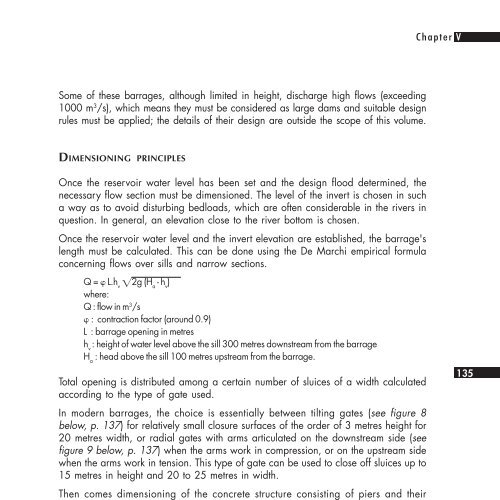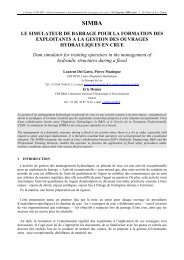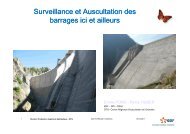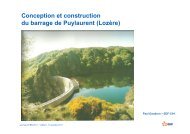SMALL DAMS
SMALL DAMS - Comité Français des Barrages et Réservoirs
SMALL DAMS - Comité Français des Barrages et Réservoirs
- No tags were found...
Create successful ePaper yourself
Turn your PDF publications into a flip-book with our unique Google optimized e-Paper software.
Chapter V<br />
Some of these barrages, although limited in height, discharge high flows (exceeding<br />
1000 m 3 /s), which means they must be considered as large dams and suitable design<br />
rules must be applied; the details of their design are outside the scope of this volume.<br />
DIMENSIONING PRINCIPLES<br />
Once the reservoir water level has been set and the design flood determined, the<br />
necessary flow section must be dimensioned. The level of the invert is chosen in such<br />
a way as to avoid disturbing bedloads, which are often considerable in the rivers in<br />
question. In general, an elevation close to the river bottom is chosen.<br />
Once the reservoir water level and the invert elevation are established, the barrage's<br />
length must be calculated. This can be done using the De Marchi empirical formula<br />
concerning flows over sills and narrow sections.<br />
Q = L.h v<br />
2g (H a<br />
- h v<br />
)<br />
where:<br />
Q : flow in m 3 /s<br />
: contraction factor (around 0.9)<br />
L : barrage opening in metres<br />
h v<br />
: height of water level above the sill 300 metres downstream from the barrage<br />
H a<br />
: head above the sill 100 metres upstream from the barrage.<br />
Total opening is distributed among a certain number of sluices of a width calculated<br />
according to the type of gate used.<br />
In modern barrages, the choice is essentially between tilting gates (see figure 8<br />
below, p. 137) for relatively small closure surfaces of the order of 3 metres height for<br />
20 metres width, or radial gates with arms articulated on the downstream side (see<br />
figure 9 below, p. 137) when the arms work in compression, or on the upstream side<br />
when the arms work in tension. This type of gate can be used to close off sluices up to<br />
15 metres in height and 20 to 25 metres in width.<br />
Then comes dimensioning of the concrete structure consisting of piers and their<br />
foundation slabs and of the invert. A barrage type structure functions like a gravity<br />
dam and the actions involved are:<br />
!"pressure of water on the gates transferred via the arms to the trunnions, as well as<br />
pressure on the cutwater;<br />
!" dead weight of the structure;<br />
!" uplift;<br />
!" ground reaction.<br />
Using these various actions, stability is studied as explained previously under the<br />
heading Stability Analysis (see p. 122). Foundation slab dimensions must enable a<br />
distribution of forces such that stresses are less than the ground's bearing capacity.<br />
Very often, this type of dam is built in alluvial valleys, so a check must be made that<br />
there is no risk of flow around the structure or of piping.<br />
135

















